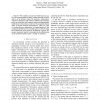WCNC
2008
IEEE
14 years 7 months ago
2008
IEEE
—1 In ISM bands, many wireless protocols proliferate such as 802.11, Bluetooth, and ZigBee. However, these incompatible protocols create complex coexistence and connectivity prob...
WCNC
2008
IEEE
14 years 7 months ago
2008
IEEE
—Neighbors of both the transmitter and the receiver must keep quiet in a 802.11 wireless network as it requires bidirectional exchange, i.e., nodes reverse their roles as transmi...
WCNC
2008
IEEE
14 years 7 months ago
2008
IEEE
Abstract—The sparse network topology, coupled with the limited availability of reference nodes in Under Water Sensor Network (UWSN), significantly reduces the effectiveness of m...
WCNC
2008
IEEE
14 years 7 months ago
2008
IEEE
The Sensor Internet provides access to sensor services by connecting sensor nodes to the Internet infrastructure. To achieve this, current solutions rely on fixed access points or ...
WCNC
2008
IEEE
14 years 7 months ago
2008
IEEE
—The hot spot problem is a typical byproduct of the many-to-one traffic pattern that characterizes most wireless sensor networks: the nodes with the best channel to the sink are ...
WCNC
2008
IEEE
14 years 7 months ago
2008
IEEE
— In this paper, we investigate two selective relaying schemes in cooperative OFDM systems. Selective OFDMA relaying, where the relay selection is performed in a per-subcarrier m...
WCNC
2008
IEEE
14 years 7 months ago
2008
IEEE
—We present a system-level approach to localizing and tracking users on a basis of different sources of location information. We have applied a combination of the Cricket system ...
WCNC
2008
IEEE
14 years 7 months ago
2008
IEEE
Abstract— We consider a scenario in which frequency agile radios opportunistically share a fixed spectrum resource with a set of primary nodes. We develop a collaborative scheme...
WCNC
2008
IEEE
14 years 7 months ago
2008
IEEE
—Temporal-Angular channel sounding measurements of an indoor millimeter wave channel (60 GHz) is analyzed to determine whether ray arrivals at the receiver form clusters in the t...
WCNC
2008
IEEE
14 years 7 months ago
2008
IEEE
—Physical Carrier Sensing plays a crucial role in the effectiveness of CSMA-based MAC protocols, yet its properties and impact on the system performance under slow fading channel...



